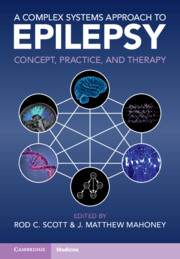Book contents
- A Complex Systems Approach to Epilepsy
- A Complex Systems Approach to Epilepsy
- Copyright page
- Contents
- Contributors
- Chapter 1 Introduction
- Chapter 2 Systems Biology Approaches to the Genetic Complexity of Epilepsy
- Chapter 3 Transcriptomic and Epigenomic Approaches for Epilepsy
- Chapter 4 Phenomenological Mesoscopic Models for Seizure Activity
- Chapter 5 Personalized Network Modeling in Epilepsy
- Chapter 6 The Baseline and Epileptiform EEG
- Chapter 7 Neuronal Approaches to Epilepsy
- Chapter 8 Mapping Epileptic Networks with Scalp and Invasive EEG
- Chapter 9 A Neuroimaging Network-Level Approach to Drug-Resistant Epilepsy
- Chapter 10 Epilepsy as a Complex Network Disorder
- Index
- References
Chapter 7 - Neuronal Approaches to Epilepsy
Published online by Cambridge University Press: 06 January 2023
- A Complex Systems Approach to Epilepsy
- A Complex Systems Approach to Epilepsy
- Copyright page
- Contents
- Contributors
- Chapter 1 Introduction
- Chapter 2 Systems Biology Approaches to the Genetic Complexity of Epilepsy
- Chapter 3 Transcriptomic and Epigenomic Approaches for Epilepsy
- Chapter 4 Phenomenological Mesoscopic Models for Seizure Activity
- Chapter 5 Personalized Network Modeling in Epilepsy
- Chapter 6 The Baseline and Epileptiform EEG
- Chapter 7 Neuronal Approaches to Epilepsy
- Chapter 8 Mapping Epileptic Networks with Scalp and Invasive EEG
- Chapter 9 A Neuroimaging Network-Level Approach to Drug-Resistant Epilepsy
- Chapter 10 Epilepsy as a Complex Network Disorder
- Index
- References
Summary
The previous chapters have dealt with the complex adaptive nature of the genome. Similar concepts in terms of interacting elements, self-organization and adaptation can be applied at other hierarchical scales. In this chapter we will show how complex adaptive systems (CAS) concepts can be usefully applied at the level of action potential firing patterns of single neurons in terms of seizure generation and of associated morbidities.
- Type
- Chapter
- Information
- A Complex Systems Approach to EpilepsyConcept, Practice, and Therapy, pp. 86 - 98Publisher: Cambridge University PressPrint publication year: 2023



